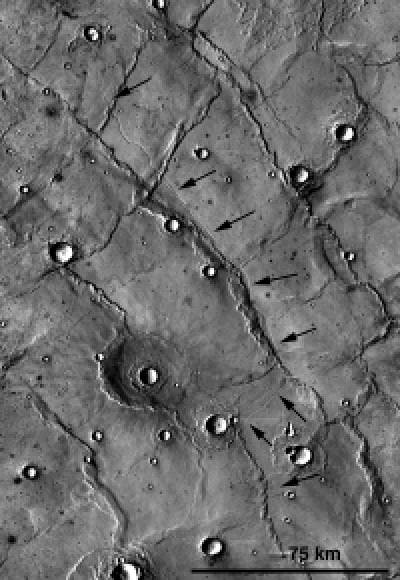[/caption]
When the first spacecraft flew by Mars in the 1960’s, the images returned revealed a relatively uninteresting-looking place, featureless in some areas and pockmarked with craters in most others. It looked a lot like the Moon. Later flybys and orbiting probes, however, gave us a closer look at other regions on the planet, providing a glimpse of what Mars is really like: a world of mountains, volcanoes, canyons, craters, old riverbeds and polar ice caps. It is little surprise then, that these striking geologic features captured scientists’ attention the most, and so areas like Hesperia Planum, a flat, relatively dull-looking plain, have received less attention over the years.
But there is a mystery in this region in the form of geologic features called rilles. No one has been able to figure out where they came from or how they formed.
The rilles in Herperia Planum are a series of about a dozen narrow, sinuous channels. They are up to a few hundred meters wide, and hundreds of kilometers long, but don’t appear to have any sources or destinations. The assumption has been that they were most likely created by lava flows, like their counterparts on the Moon. But apart from one very small volcano, there is little evidence of any volcanism in Hesperia Planum, which makes the appearance these rilles difficult to explain.
Another explanation could be water, but again, there are no obvious sources or other indications of past water in this region.
These enigmatic features have been the subject of study by scientists from the University at Buffalo, State University of New York. Geologist Tracy Gregg and her student Carolyn Roberts have been comparing them to rilles on the Moon, and their preliminary findings were presented today at the Annual Meeting of The Geological Society of America, in Minneapolis, and they hope to find some answers in further study and collaboration with other scientists.
“On the Moon we see these same kinds of features and we know that water couldn’t have formed them there,” Gregg said. “Everybody assumed these were huge lava flows, But if it turns out to be a lake deposit, it’s a very different picture of what Mars was doing at that time.”
So, were they formed by water, lava or something else? If it turned out to be water, that would of course be more interesting in terms of the search for possible habitable areas in Mars’ past.
Whichever explanation turns out to be correct, or even a different one, it will be one more piece of evidence which helps to further our understanding of this fascinating world, so much like our own in some ways, yet utterly alien in others
The paper is available here and additional photos are here.
Source: EurekAlert


Giant Sandworms?.. 🙂
more likely to be caused by electrical arc scarring
Could lava, or even water flows adequately explain the rough angular geometry, like rills intersecting at right-angles? Curious; in mentally deleting the crater features, the overall pattern of image has a somewhat familiar look: Some Earth-place topography, perhaps, or top of some oven-heated baked good, after cooling. The surface geometry of these features is intriguing: rille-divided strips of Martian terrain, subdivided into square-like segments. Maybe a sub-crustal, heat-intensive process, pressing up from below? Past rising convection currents of mantle material? But how square the topography with an edge of rille?
Ice, in a glacial layer underneath the surface, which subsequently partially or completely evaporated or sublimated due to some process we don’t know about yet? It looks as if the whole area may have been an elevated plateau or low dome which subsided, leaving compression wrinkles. (I doubt that’s the geological term.)
Well there are no plate tectonics on Mars so all the surface features are caused either by bombardment or a slowly cooling crust. It DOES look like baked goods in that regard eh?
Clearly aliens. Probably the same ones responsible for the canals on Mars and the face on Mars. Richard Hoagland would probably know what kind of aliens and what the structures are for. We should ask him…
Glaciers will do this in certain circumstances on earth with under-glacier rivers laying down similar patterns. I would not be surprised if the same has occured on Mars, although probably smaller and less thick. I do not see large amounts of till as in parts of Canada especially the mountains as the glaciers retreat but, looking for it, may result in more discoveries!
I checked the footprint… tire tracks of a 1969 Olds Toronado…. 😉
Well, they look like cracked Martian plates to me.